Key takeaways:
- Culinary education encompasses not only cooking techniques but also the cultural and historical significance of food and spices.
- Spices have played a crucial role in shaping economies and societies throughout history, influencing global trade and culinary diversity.
- Incorporating spices into dishes enhances flavors, evokes cultural connections, and offers health benefits, highlighting their importance in cuisine.
- Personal experiences with spices can deepen appreciation for culinary traditions and create opportunities for cultural exchange and shared experiences.
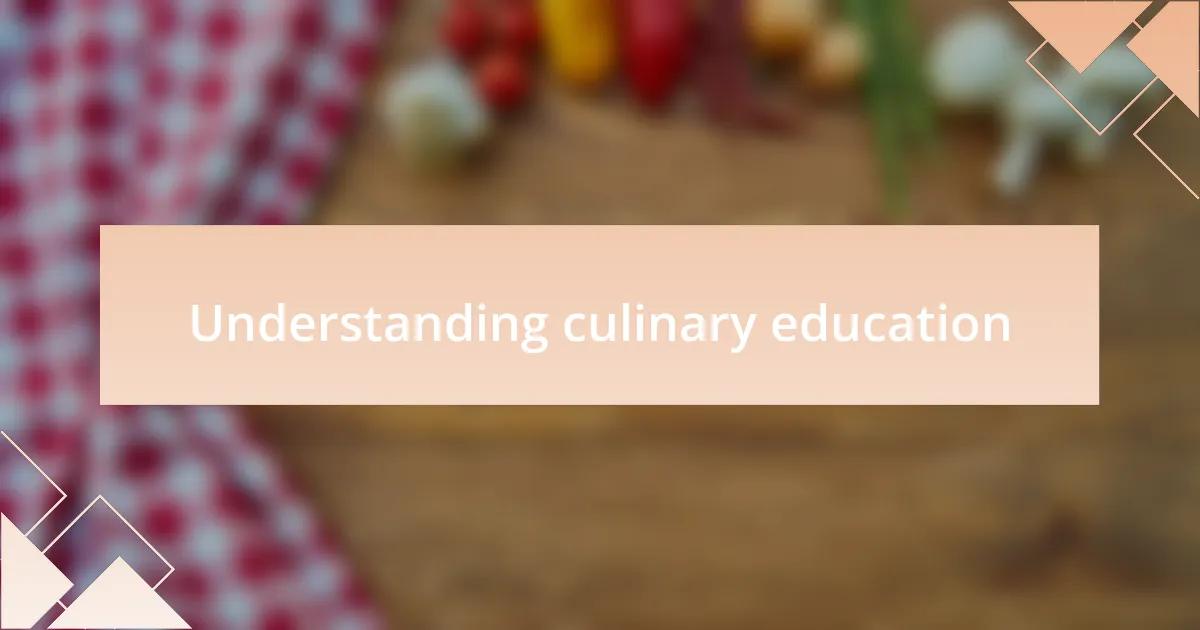
Understanding culinary education
Culinary education goes beyond just learning how to cook; it’s a deep dive into food culture, history, and techniques that shape our culinary world. I remember my first day in culinary school, overwhelmed by the plethora of spices lined up before me. Each spice had a story, a history that we unpacked over the weeks, making me wonder—how can something as small as a nutmeg influence global trading routes and cuisines around the world?
I often reflect on the profound connection between culinary education and creativity. It is in the kitchen that I’ve experienced the freedom to experiment and innovate, transforming traditional recipes into contemporary dishes. Have you ever thought about how much of our culinary heritage relies on the wisdom and passions of those who came before us?
In this journey through culinary education, I’ve come to appreciate the meticulousness of techniques and the importance of tasting as a learning tool. Every chop, sauté, and seasoning adjustment we make is a lesson in patience and precision. It’s like poetry; the way flavors come together tells a story that resonates with our identities.
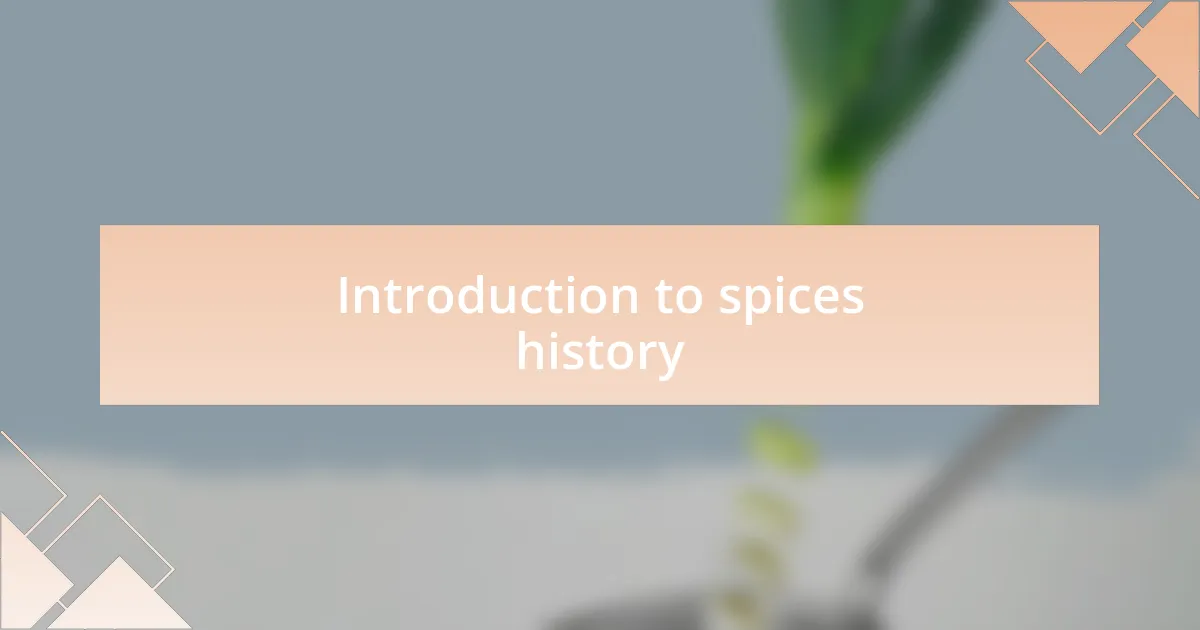
Introduction to spices history
Spices have laced the fabric of human history since ancient times, serving not only as flavor enhancers but also as valuable commodities. I still recall the first time I learned how trade routes emerged, with spices like cinnamon and pepper being worth their weight in gold. Can you imagine how a tiny vial of cardamom could spark adventures across distant lands and cultures?
As I delved deeper into this fascinating narrative, I discovered that spices played a pivotal role in shaping economies and societies. For instance, the pursuit of spices fueled explorations in the Age of Discovery, changing maps and, inevitably, the course of history itself. It left me pondering—what if those sea voyages had never taken place? Would our culinary landscape be as vibrant and diverse as we know it today?
The rich history of spices is not just a tale of economics; it’s a tapestry woven with stories of human connection and cultural exchange. When I blend spices in my dishes today, I can almost feel the echoes of ancient traders sharing their secrets and recipes. Have you ever thought about how each sprinkle carries the essence of different cultures and traditions? The exploration of spices truly is a journey into the heart of our global heritage.
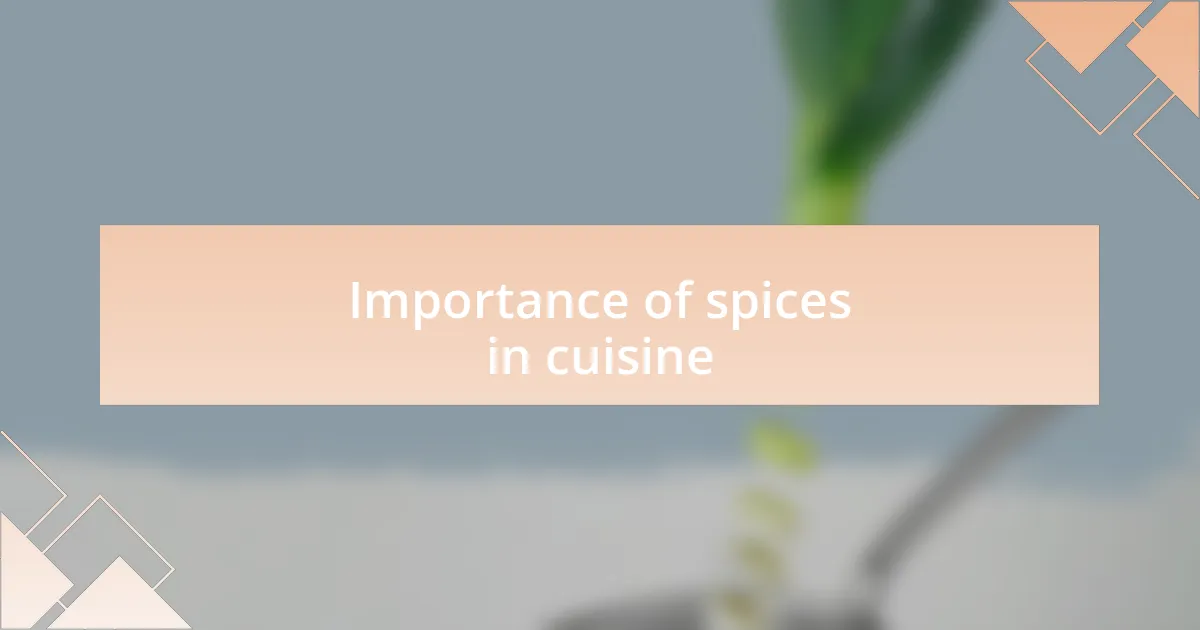
Importance of spices in cuisine
Spices are the soul of a dish, transforming simple ingredients into culinary masterpieces. I remember experimenting with saffron for the first time; its delicate aroma and vibrant color turned a basic risotto into something extraordinary. Isn’t it fascinating how a simple pinch can elevate our everyday meals, making them feel special and memorable?
Moreover, spices serve as cultural markers, telling stories of where we come from and how we connect with others. When I prepare a curry filled with turmeric and cumin, it feels more than just a meal; it’s a celebration of my heritage. Have you noticed how certain spices evoke memories, bringing the flavors of home right back to our plates?
Finally, the health benefits tied to spices add another layer to their importance in cuisine. For instance, I’ve found that incorporating ginger into my diet has not only enhanced the flavor of my dishes but has also made me feel more energized. Isn’t it incredible to think that by simply exploring spices, we can discover not just new flavors but also ways to nourish our bodies?
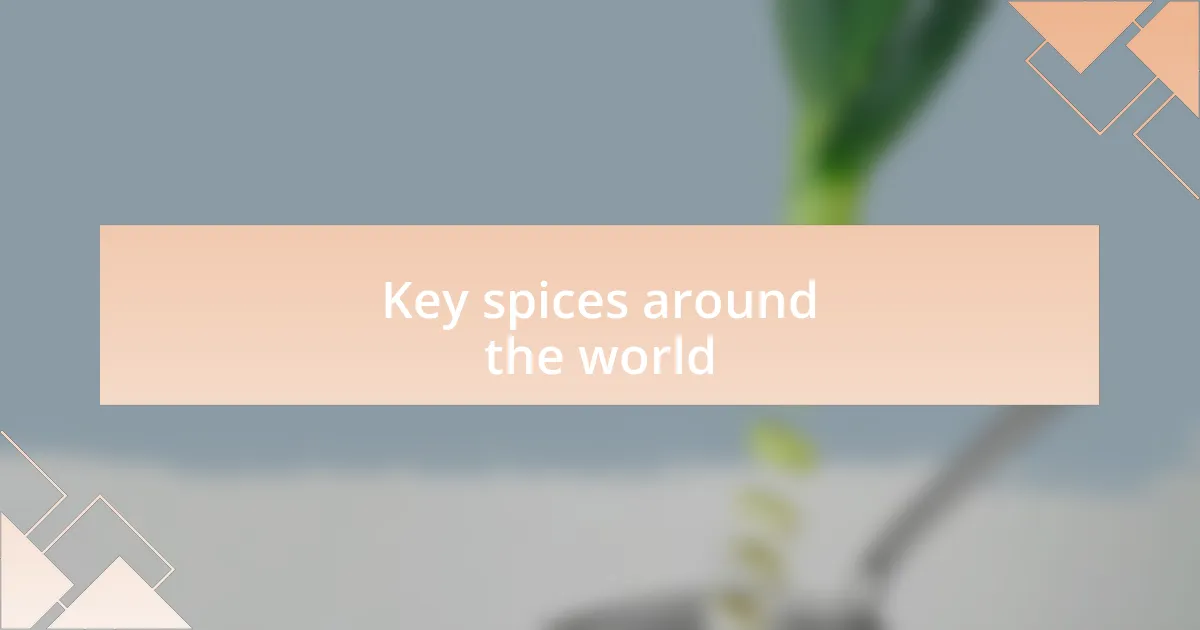
Key spices around the world
When it comes to key spices around the world, there are a few that truly stand out. Take cinnamon, for example. I often think back to the first time I added it to a chai latte; that warmth and sweetness instantly filled my kitchen with a comforting aroma that made the whole experience more inviting. This spice, revered in various cultures, is not just a flavor enhancer but also deeply intertwined with traditions, from festive desserts to everyday brews.
Then there’s chili pepper, a staple that ignites dishes and adds a thrilling kick to our meals. I can vividly recall one summer evening when I decided to experiment by mixing different chili varieties in a homemade salsa. The fiery burst was exhilarating, and I couldn’t help but wonder how this spice has the incredible ability to connect us—whether it’s a spicy taco night with friends or a fiery curry enjoyed with family. Isn’t it remarkable how heat can bring people together?
Finally, let’s not overlook garlic, often dubbed the “king of spices.” Its pungent aroma, wafting through my kitchen while sautéing, always evokes feelings of nostalgia. I remember cooking pasta for my friends and watching their faces light up with delight as they tasted the harmony of garlic, olive oil, and herbs. Isn’t it amazing how one simple ingredient can bridge cultures and create unforgettable moments around the dinner table?
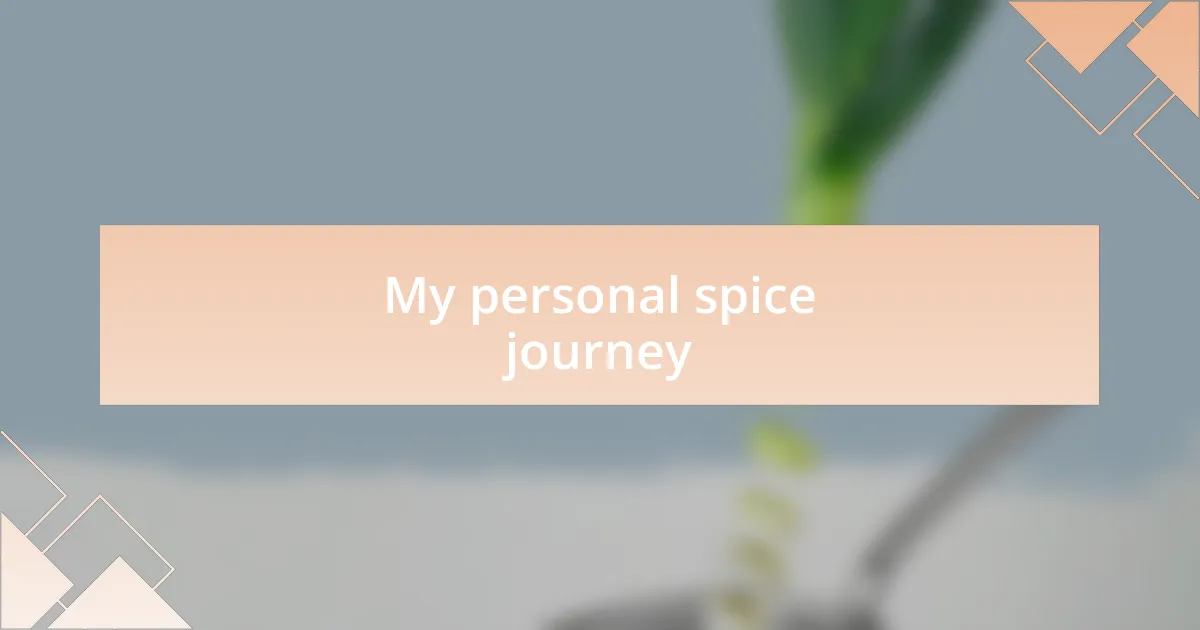
My personal spice journey
There was a turning point in my spice journey when I discovered saffron. I vividly recall standing in a bustling market in Morocco, surrounded by vibrant colors and the heady scents of spices. When I finally tasted a dish infused with saffron, its delicate floral notes and deep golden hue took my breath away. Isn’t it fascinating how a single strand can transform an entire dish into something luxurious and memorable?
As I’ve explored spices further, I can’t help but reminisce about a cooking class I attended focused on Indian cuisine. The moment the teacher introduced me to the complex layering of spices in a masala, I felt a rush of excitement. I remember mixing cumin, coriander, and turmeric, and the way the aroma enveloped the room. It made me appreciate how spices tell stories of heritage and culture, don’t you think?
Most recently, I embarked on a quest to understand the role of spices in global health. I started incorporating turmeric into my morning smoothies, motivated by its anti-inflammatory properties. What surprised me most was how a dash of this vibrant spice not only enhanced flavor but also sparked conversations with friends about our health journeys. Isn’t it remarkable how spices can connect us, not just through taste, but through shared experiences and wellness?
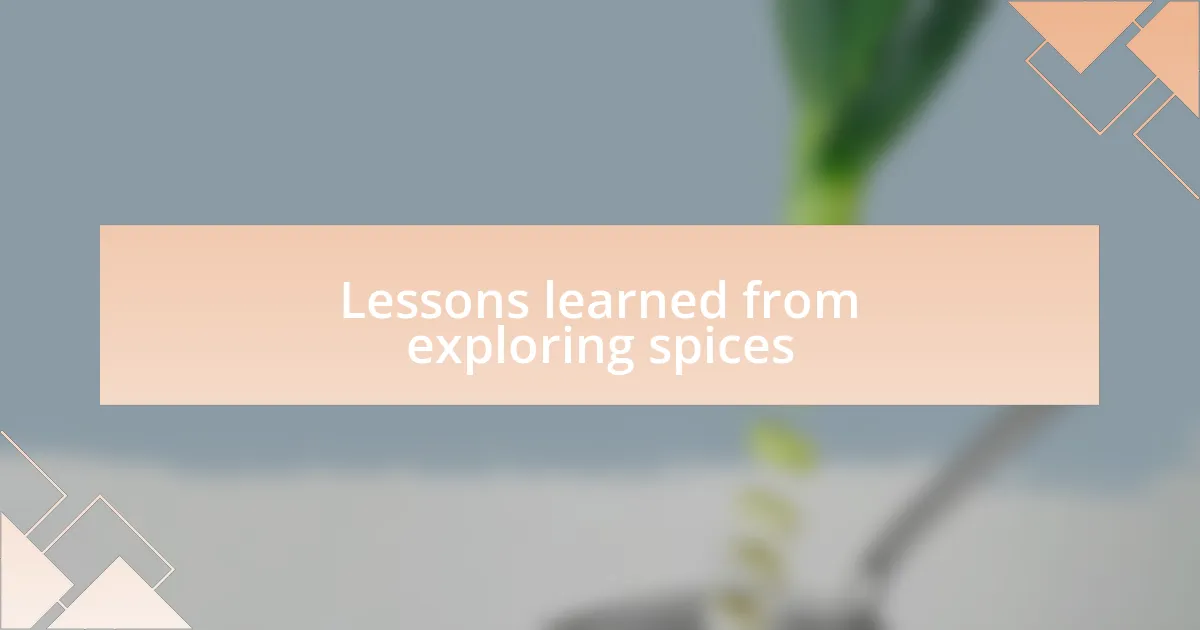
Lessons learned from exploring spices
Exploring spices has taught me the importance of patience and balance, especially when experimenting with flavors. I recall a time I tried to create a homemade spice blend and got a bit too eager, adding too much chili powder. The result was an overpowering mix that left my taste buds on fire! That experience highlighted how a thoughtful approach to spices can elevate a dish, whereas haste can lead to overwhelming outcomes. Have you ever found yourself in a similar situation?
One significant lesson is that spices possess the power to bridge cultures. During a dinner party, I served a Moroccan tagine enriched with cinnamon and almonds. As my guests savored the dish, we embarked on a discussion about our own family recipes and culinary backgrounds. I was amazed at how a simple blend of spices could evoke rich memories and stories. It reinforced my belief that spices are not just ingredients; they’re catalysts for connection among people.
Another valuable insight has been the versatility of spices in cooking. I once decided to try cardamom in a classic vanilla cake recipe. The outcome was transformative; the fragrant spice introduced a warm complexity that made the cake so much more than just a sweet treat. This experience taught me to embrace experimentation in the kitchen, reminding me that the magic of spices often lies in their unexpected combinations. What new spice will you try next?

Recipes featuring diverse spices
One of my favorite recipes that showcases diverse spices is a simple curry. I remember the first time I unexpectedly added turmeric to a chicken dish—it transformed the whole flavor profile. The beautiful golden hue was only the beginning; the warmth and earthiness of the turmeric, coupled with cumin and coriander, created a comforting balance that made each bite feel like a warm hug. Have you ever been surprised by how a single spice can elevate an ordinary meal?
I often experiment with different spice blends when making roasted vegetables. One memorable evening, I reached for a za’atar mix—a Middle Eastern blend of thyme, sumac, and sesame seeds. Tossing my veggies in that mix before roasting brought an entirely new dimension to their natural sweetness, making them a standout side dish. Have you tried using spices in ways that surprise your palate? I believe cooking should be about exploration, and spices are a perfect gateway to discover new flavor landscapes.
For dessert, I love making chai-spiced chocolate truffles. Adding ground cardamom and ginger to rich, dark chocolate created a luxurious treat that was unlike anything I’d tasted before. The fragrant spices turned a simple dessert into an aromatic experience that lingered long after the last bite. Have you noticed how spices can transform even the sweetest moments? Each indulgence becomes a journey through cultures, reminiscent of the vibrant markets where these spices first originated.